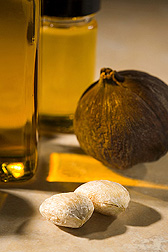This page has been archived and is being provided for reference purposes only. The page is no longer being updated, and therefore, links on the page may be invalid.
Read the magazine story to find out more. |
|
|
Breeding Plants to Produce Industrial Oils
By Erin PeabodyAugust 2, 2007
Plants do the most amazing things. They're a steady source of life-sustaining oxygen, food, fiber for clothing and, increasingly, renewable fuels.
As if that weren't enough, scientists with the Agricultural Research Service (ARS) are also eyeing these leafy dynamos as a virtual spring of never-before-seen oils that could someday rival petroleum in industrial uses and even stave off heart disease.
Plants are already tapped for a variety of useful oils—think of the shimmering liquids pressed from canola, corn and olives—but most of them are destined for the skillet or dinner plate.
However, an even greater potential for oilseed crops, according to John Dyer—who works at the agency's Southern Regional Research Center (SRRC) in New Orleans, La.—resides in their capacity to pump out unusual fatty acids that have valuable chemical, industrial and nutritional properties. Fish-oil-type fatty acids derived from plants, for instance, could benefit the heart, brain and eyes.
Dyer, a chemist, and Jay Shockey, a plant geneticist who also works at the SRRC, are getting inspiration from tung trees for how plants could be coaxed into churning out such impressive oils.
Tung trees, which used to be cultivated in great plantations along the U.S. Gulf Coast, produce eleostearic acid, an unusual fatty acid with applications ranging from furniture finish to computer chip production. The trees' major shortcomings? They're slow to grow and vulnerable to hurricanes.
Similar limitations apply to other currently grown oilseed crops. With traditional breeding alone, it's almost impossible to raise crops that will manufacture abundant amounts of unusual fatty acids.
That's why Dyer and Shockey are looking to engineer plants that will practically gush forth unique fatty acids, such as eleostearic acid. They recently discovered that a gene involved in the production of the important enzyme DGAT2—short for diacylglycerol acyltransferase type-2—may well be the "magic bullet" for boosting plants' oil-oozing abilities.
Read more about the research in the August 2007 issue of Agricultural Research magazine.
ARS is the U.S. Department of Agriculture's chief scientific research agency.

